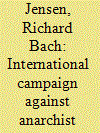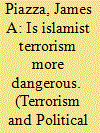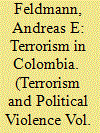| Srl | Item |
| 1 |
ID:
087355


|
|
|
|
|
| Publication |
2009.
|
| Summary/Abstract |
This essay presents a short overview of the "classic" era of anarchist terrorism between 1880 and World War I, while concentrating on an analysis of the little-known efforts by diplomats, politicians, and the police to control and repress anarchist terrorism. These efforts included the Rome Anti-Anarchist Conference of 1898 and the St. Petersburg Protocol of 1904. Before World War I, a combination of economic, social, and political factors, combined with a systematic government effort to redefine and downplay the nature and importance of anarchist terrorism provides the best explanation for why this form of violence declined in certain countries but not in others. Careful police intelligence work and international police cooperation, together with a more rigorously professional system of protection for monarchs and heads of state, could aid in reducing the problem of anarchist terrorism, but heavy-handed repression only worsened it. The essay concludes with a sketch of anarchist terrorism after 1914 and a brief comparison between present-day terrorism and its nineteenth-century predecessor.
|
|
|
|
|
|
|
|
|
|
|
|
|
|
|
|
| 2 |
ID:
087357


|
|
|
|
|
| Publication |
2009.
|
| Summary/Abstract |
Since September 11, 2001 the threat from international terrorism has led to a greatly increased programme of counterterrorism legislation from the British government, yet it has contradictorily introduced legislation aimed at normalizing society in Northern Ireland. Prime Minister Tony Blair led the way in proclaiming differences between terrorism related to Northern Ireland and terrorism that is international in scope in order to create and enact a two-tier system of terrorism legislation in the United Kingdom. This article will examine Blair's decade in power and his role in distinguishing between, and legislating differently for, the two forms of terrorism.
|
|
|
|
|
|
|
|
|
|
|
|
|
|
|
|
| 3 |
ID:
087354


|
|
|
|
|
| Publication |
2009.
|
| Summary/Abstract |
Scholars have traditionally argued that Islamist terrorist groups tend to commit higher casualty attacks. Noting that casualty rates of attacks vary widely across Islamist terrorist groups, this study advances an alternative hypothesis that group organizational features and goal structures better explain differing casualty rates than does the overarching ideological type. Using both cross-national analysis and a case study of post-invasion Iraq, I demonstrate that there are two basic types of Islamist terrorist groups whose organizational and goal-structure features explain divergent casualty rates: "strategic groups" that function similarly to secular national-liberation and regime-change movements and "abstract/universal groups" that are affiliated with the global al-Qaeda network.
|
|
|
|
|
|
|
|
|
|
|
|
|
|
|
|
| 4 |
ID:
087352


|
|
|
|
|
| Publication |
2009.
|
| Summary/Abstract |
This article uses ITERATE data on international terrorism 1968-2004 to test Rapoport's wave-like behavior of modern terrorism. While the interpretation encompasses a much longer period of time than can be tested empirically with readily available data, it is possible to examine the past 3-4 decades of terrorist activity for traces of the coming and going of old and new groups. The article codes the type of group (anarchists, nationalists, leftists/Marxists, and religious fundamentalists) and then examines the type of tactics employed, deaths, and targets across time. The results confirm the presence of heterogeneous, wave-like behavior that conforms to the Rapoport interpretation as new and old groups/tactics/issues cycle in and out of activity.
|
|
|
|
|
|
|
|
|
|
|
|
|
|
|
|
| 5 |
ID:
087353


|
|
|
|
|
| Publication |
2009.
|
| Summary/Abstract |
This article examines contemporary uses of terrorism in Colombia. Combining an historical analysis with the most complete database available on political violence, we illustrate how terrorism in Colombia constitutes a specific strategy that can be distinguished from other manifestations of violence. We argue that Colombia's non-state armed groups have turned terrorism into a pivotal element of their repertoires of action. These parties have not only increased their reliance on this strategy and introduced more refined forms such as de-territorialized terrorism, but also have specialized in particular terrorist attacks that suit their general objectives. While paramilitary groups rely mostly on massacres and forced disappearance, guerrillas concentrate on agitational terrorism including kidnappings and indiscriminate bombings.
|
|
|
|
|
|
|
|
|
|
|
|
|
|
|
|
| 6 |
ID:
087356


|
|
|
|
|
| Publication |
2009.
|
| Summary/Abstract |
This article uses the analytical model put forward by Kalyvas in his Logic of Violence in Civil War to explore the violent transition experienced by Barrancabermeja from 1998 onwards, when the increasing insurgent presence was curbed by paramilitary groups and government forces. While the model sheds light on the causal mechanisms that led to violence against civilians, it fails to predict some of the observed outcomes; these anomalies are discussed with a view to expanding its explanatory power. Furthermore, the paper highlights the relevance of socioeconomic factors and spatial segregation in predicting the distribution of violence.
|
|
|
|
|
|
|
|
|
|
|
|
|
|
|
|